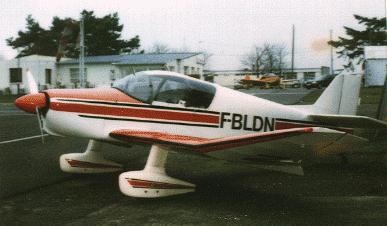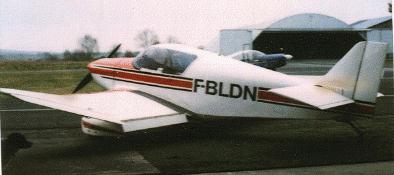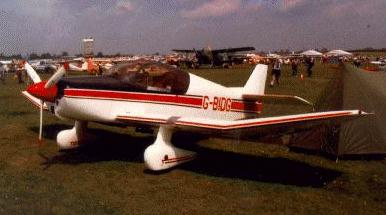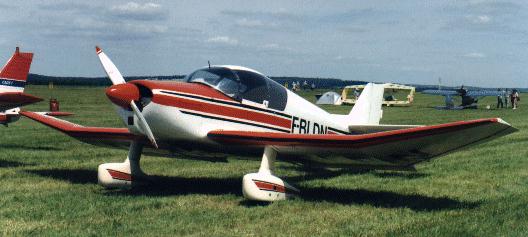
By Adrian Mc Shane

The name 'Jodel' comes from two Frenchmen, Edouard joly and his son-in-law, Jean Delemontez, who in 1946 formed an aircraft and glider repair business under the name 'Avions Jodel' , based at Beaune in france, building the single-seater D.9 Bebe for their own enjoyment but later selling plans to homebuilders. From the Bebe grew a whole series and sub - series of wood - and - fabric Jodels, built under licences granted by Avions Jodel and produced both as homebuilts and series production aircraft by various manufacturers.

|
The basis of the whole family was the superbly efficient 'bent-wing' configuration and two-three - , 2+2 and full four-seat versions came along, plus a massive five - seater, the D.140 Mousquetaire, capable of lifting its own weight in fuel, people and freight. Even today this version is still in use with the French Armee de l'Air as a trainer. Many of the earlier two -seaters, the D.117, 119 and 120 are still lovingly maintained and flying today throughout Ireland, UK and Europe. To follow them - and under the watchful eye of Jean Delemontez acting as design consultant to the SAN ( Societe Aeronautique Normande ) factory at Bernay, which built the D.117 - was developed the then - ultimate two - seater jewel, the D.150 Mascaret. |
At the time, in the early sixties, both Bernay and the CEA ( Cantre- Est Aviation, now Avions Pierre Robin ) factory at Dijon were producing the Ambassaduer, a 2+2 design with a 28 foot 7 inch wingspan, a choice of either the R-R/Continental 0-200A ( 100hp ) or the 105hp Potez 4E-20 power unit and a range of some 650 miles at about 125mph. Although these were very popular with customers at the time ( some 800 of various versions being produced ), Delemontez wanted to produce a GT version; a ' sports car ' of the air, capable of touring, basic aerobatics, and with improvements over the previous designs wherever possible. The basis of this objective was to answer a specific request from the DGAC ( Direction General de l'Aviation Civile ) for such a machine.
Delemontez started by modifying the basic Ambassadeur wing, removing one rib and wing bay from each side, leaving a span of just 26 feet 10 inches. Into this modified structure he incorporated twin wing - root tanks holding eighteen imperial gallons of usable fuel. A new - design wide - track undercarriage included excellent differential drum brakes, a considerable improvement on the narrow - tracked Scott - bladdered fitment of the earlier two - seaters.
The new undercarriage endowed the Mascaret ( the name derives from a tidal bore which rushes up a nearby Normandy river ) with both ruggedness and improved ground handling, with the crosswind limitation being increased to a useful twenth knots. Finally, narrow chord mechanically - operated plain flaps were added, with two settings - twenty degrees for take - off and ( where appropriate ) fifty degrees for landings. The wing section remained the same NACA 23012, but production examples were also fitted with navigation lights and a powerful landing light in the port wing leading edge.
Delemontez next took the standard Ambassadeur fuselage and incorporated several modifications. It was shortened by some nine inches, the cabin was widened by some four inches and sufficient depth, area and rear clearance were designed into the instrument panel to allow for the fitting of a full set of avionics and blind - flying instruments. Two venturis of the larger size were hung under the floor, aesthetically out of sight and serving the artificial horizon, directional giro, and turn - slip through a novel distribution gauge, which also measures the amount of vacuum available and if this becomes insufficient for whatever reason, it can turn one or more of the air - driven instruments off - line.
In the space normally occupied by two French enfants terribles a large parcel shelf was provided, capable of supporting somewhat more than the usual GT toothbrush and comb luggage. This can hold up to sixty kilos of evenly distributed baggage, depending on fuel load, because immediately below it is the third long - range fuel tank, which holds a massive 23 gallons. Thus, the Mascaret is capable of carrying 41 gallons of usable fuel, giving it a practical and unique range ( for such an aircraft ) of some 1000 miles.
In order to get maximum performance in all the very different roles the aeroplane would have to play, from two - seater trainer to fully - loaded tourer, with an additional requirement to perform basic aerobatics, Delemontez completely modified the rear part of the Ambassadeur fuselage with a fixed fin/rudder configuration, replacing the earlier all - flying tailfin. More importantly, an all - flying stabilator with a servo/trim tab was introduced. This is designed to ensure maximum flight efficiency by allowing minimum induced tailplane drag throughout the whole C of G range. Stick forces throughout any combination of speed/loading can always be trimmed out and sufficient elevator authority is always available in the flare and landing/take - off configurations. This stabilator was fitted from the second example onwards and was ultimately incorporated into later Ambassadeurs and all subsequent Jodel - inspired designs up to and including the current production Robin DR400 series.
|
By using the 0-200A or the Potez ( which when fitted gave the aircraft the designation 'D.150A' ) as fitted to earlier models of Ambassadeur, SAN were able to offer their customers an aircraft of exceptional range, speed, comfort and overall capability, whilst still retaining a fuel burn in the low twenty litres per hour. The reliability factor of known power units in which potential customers would have confidence was also an important marketing and design consideration. |

|
Two prototypes were originally built, the first ( F-BJST ) being fitted with the 0-200A and still flying in France. ( The second example was powered by the Potez 4E-20 and is now flying in the UK as G-BPAM. ) The first flight of prototype 01 was from the SAN airfield at Bernay in Normandy in the hands of Jacques Ernoult, SAN's Commercial Director and Chief Pilot since March 1960. He played a major role in the Mascaret's development and design.
Years later Ernoult was asked about that first flight. His reply was,"The Mascaret was a superb aeroplane! A marvelous aeroplane! Jean Delemontez had designed this Jodel following a request from the DGAC who wanted a two - seater with long range and versatility. It succeeded perfectly... he brought us his plans and in turn, Jacques Heligoin , who was the principal foreman, made it into reality. The series production Mascarets had very little modifications from the prototype, apart from the installation of the all - flying tailplane ( profondeur monobloc ). Otherwise, what an aeroplane! Range, comfort, quiet, one couldn't get better..."
Construction ran to a total of 62 aircraft prior to a series of disasters including the death of SAN boss Lucien Querey, followed by a fire which all but destroyed the factory. Only 61 saw the light of day, No. 62 being originally earmarked for further development, including the installation of a 115 hp Lycoming engine. Sadly, this never materialized and the bare, uncovered wing and fuselage lay gathering dust for almost twenty years before being purchased by an enthusiastic UK Jodel restorer - it was completed with a Lycoming 0- 235 engine, gaining the designation Super Mascaret.
Some Mascarets were bought by French flying clubs and used for circuit training as well as advanced work, while a greater number went to private owners throughout Europe. The Tiger Club at Redhill was an early customer through their chairman, the late Norman Jones ( an enthusiastic Jodeller - at one time his Rollason company held the import rights for the marque ). Their original Mascaret G-ASPG was written off in a crash in 1966, but later replaced by the Tiger Club's present, G-AVEF, which is a earlier example, being imported second - hand from France. ( G-ASPG was bought new from Bernay. ) Since that time 'EF has accumulated hundreds of touring and racing flying hours and the many Tiger Club members who have flown her can testify to the excellent all - round capability of the design.
In 1980 a small change to the PFA's eligibility list, which detailed what could and could not be operated on a Permit to Fly, included the previously inexplicably barred Mascaret. Within months UK Jodel enthusiasts were searching the airfields and hangars of Europe and about a dozen Mascarets were quickly liberated from under the ( then uninterested ) noses of their owners.

|
Thirty - two Mascarets ( plus the uncompleted example ) were tracked down in all, the remainder having been written off or cancelled for a variety of reasons. At present eighteen of these are airworthy in the UK, with all the others continually being chased by those unlucky enough to have missed the first wave, before the French realized what was happening to some of their finest aeroplanes. ( In fact, by Dec '95 the score was 33 airworthy, split into : france, eight, including one in Djibouti; Germany, six; Belgium, one; UK, eighteen. ) |
Recently though, and to the chagrin of many an aspiring British Jodeller hoping to liberate another example, many astute Europeans have recognized the true worth of the marque, and have themselves restored or even built new examples of the Jodel Mascaret ( three are currently under construction in the UK and Ireland ). This is due to several factors such as rising fuel costs, increasing evidence of corrosion in the Rallyes for which many Jodels were exchanged, plus the high repair and maintenance costs of more modern aircraft such as the Socata Tobago range. If and when any of these Mascarets are sold, it is at prices even higher than those currently being sought in the UK. For example, a 3.000+ hour, ex - flying club Mascaret, totally unrestored and needing at least a re - cover, changed hands in France in 1995 for Ff180.000 - about £22.000 at exchange rates at the time.
Many years after the Mascaret had gone out of production, both Jean Delemontez and his father - in - law Edouard Joly were asked which was their particular favourite out of all the Jodel designs and sub - types which they had built or been involved with. Not surprisingly, and without hesitation, both chose the D.150. The type is therefore worthy of closer examination.
Many thanks to Adrian Mc Shane for allowing me to publish his article here.
Author Hans Teijgeler
The photos in this web site are from the excellent book by Xavier Massé,
sent in by happy Jodel owners, lifted from the web or taken by myself.